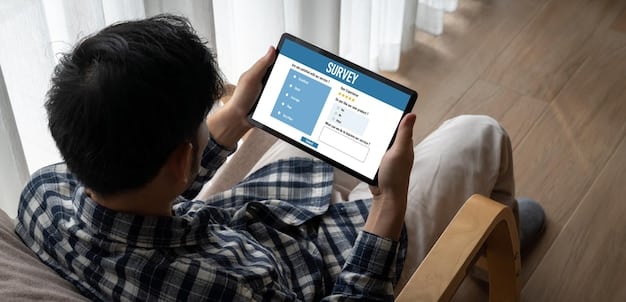Digital Communication Accessibility: Ensuring Inclusive Messages for Everyone

Digital Communication Accessibility ensures that electronic messages and online content are inclusive and usable by individuals with disabilities, allowing equitable participation in the digital world.
In today’s hyper-connected world, digital communication is pivotal. Digital Communication Accessibility: Ensuring Your Messages Are Inclusive for Everyone is not just a best practice; it’s a necessity for fostering inclusivity and ensuring that everyone can participate fully in our digital society.
Understanding Digital Communication Accessibility
Digital communication accessibility aims to make all forms of digital content usable for people with disabilities. This includes email, websites, social media posts, videos, and more.
Ensuring accessibility means considering impairments such as visual, auditory, motor, and cognitive. Digital communication accessibility is about eliminating barriers that prevent anyone from accessing, understanding, or interacting with digital content.
Why Accessibility Matters
Ignoring accessibility isolates individuals and potentially exposes organizations to legal and reputational risks.
- Legal Compliance: Accessibility is often mandated by laws like the Americans with Disabilities Act (ADA) and Section 508 in the U.S.
- Inclusivity: Creates an inclusive environment where everyone can participate.
- Wider Audience Reach: Improves usability for all users, not just those with disabilities.
By adhering to accessibility standards, businesses improve user experience and demonstrate corporate social responsibility.
Web Content Accessibility Guidelines (WCAG)
The Web Content Accessibility Guidelines (WCAG) are internationally recognized standards for web accessibility. Following these guidelines helps in creating digital content that is perceivable, operable, understandable, and robust (POUR).
Understanding these guidelines ensures that content is accessible across various devices and assistive technologies.
Key Principles of WCAG
WCAG is built around four main principles, each with guidelines to help creators make their content accessible.
- Perceivable: Information and user interface components must be presentable to users in ways they can perceive.
- Operable: User interface components and navigation must be operable.
- Understandable: Information and the operation of the user interface must be understandable.
- Robust: Content must be robust enough that it can be interpreted reliably by a wide variety of user agents, including assistive technologies.
Implementing WCAG compliance means considering alternative text for images, captioning videos, and structuring web pages logically.

Making Emails Accessible
Email accessibility is crucial for professional communication. Emails should be designed to be compatible with screen readers and other assistive technologies.
Simple formatting, descriptive subject lines, and appropriate use of headings can greatly improve email accessibility.
Tips for Accessible Emails
Applying accessibility best practices to email ensures that everyone can understand your message.
- Use Clear Subject Lines: Provide a summary of the email’s purpose in the subject line.
- Apply Proper Formatting: Use headings, lists, and short paragraphs to structure your content.
- Include Alternative Text: Add alt text to all images so screen readers can describe them to visually impaired individuals.
Accessible emails often lead to better engagement and understanding, regardless of recipients’ abilities.
Accessible Social Media Practices
Social media is a highly visible platform where accessibility can significantly expand reach. Accessible posts improve engagement and inclusivity.
By following simple accessibility guidelines, social media content becomes usable by a wider audience.
Ensuring Social Media Accessibility
Social media platforms have features to enhance accessibility, and content creators should utilize these tools.
- Add Captions to Videos: Ensure all video content includes captions for those with hearing impairments.
- Write Descriptive Alt Text: Use alt text to describe images so screen readers can convey visual content.
- Use Camel Case for Hashtags: Capitalize the first letter of each word in a hashtag (e.g., #DigitalAccessibility) to make it more readable.
Promoting accessibility on social media sends a powerful message about inclusivity, which can enhance an organization’s reputation.

Website Accessibility Considerations
Websites are the storefront of many organizations; ensuring they are accessible is essential. Making websites accessible requires careful planning and implementation.
By considering accessibility from the outset, websites can be designed to be inclusive and user-friendly for everyone.
Key Elements for Website Accessibility
Accessible websites incorporate elements such as semantic HTML, keyboard navigation, and sufficient color contrast.
- Semantic HTML: Use HTML tags semantically to structure content logically and improve accessibility.
- Keyboard Navigation: Ensure users can navigate your website using only a keyboard.
- Sufficient Color Contrast: Ensure sufficient contrast between text and background colors to make text readable.
Accessible website design is beneficial for SEO as search engines favor well-structured and user-friendly sites. This not only ensures compliance with accessibility standards but also improves overall site performance and visibility.
Tools for Checking Accessibility
Several tools are available to help assess digital communication accessibility. Accessibility checkers can highlight issues and suggest improvements.
Regularly using these tools helps organizations maintain accessible content and address any shortcomings quickly.
Popular Accessibility Tools
These software and browser extensions can make assessing your digital content’s accessibility easier.
- WAVE (Web Accessibility Evaluation Tool): A free web accessibility evaluation tool to identify accessibility issues.
- axe DevTools: A browser extension for developers to find and fix accessibility defects.
- Accessibility Insights: Helps find and fix accessibility issues through automated and manual testing.
By using these tools, developers and content creators can ensure ongoing compliance and improve the user experience for everyone, especially those with disabilities.
| Key Aspect | Brief Description |
|---|---|
| ♿ WCAG Compliance | Adhering to WCAG standards makes content perceivable, operable, understandable, and robust. |
| 📧 Email Accessibility | Using clear subject lines, proper formatting, and alternative text in emails ensures inclusivity. |
| 📱 Social Media | Including captions in videos and descriptive alt text in images makes social media inclusive. |
| 🌐 Website Accessibility | Using semantic HTML, enabling keyboard navigation, and providing sufficient color contrast. |
FAQ – Digital Communication Accessibility
▼
Digital communication accessibility ensures that electronic messages and online content are usable by individuals with disabilities, enabling them to access and interact with digital information equitably.
▼
Accessibility is important because it promotes inclusivity, ensures legal compliance, expands audience reach, and enhances user experience for everyone, reflecting a commitment to social responsibility.
▼
WCAG (Web Content Accessibility Guidelines) are internationally recognized standards for web accessibility, focusing on making content perceivable, operable, understandable, and robust across different devices.
▼
To enhance email accessibility, use clear subject lines, structured formatting with headings, short paragraphs, and include descriptive alternative text for all images to ensure compatibility with screen readers.
▼
Tools like WAVE, axe DevTools, and Accessibility Insights help assess and ensure compliance with accessibility standards by identifying and fixing issues related to digital content usability.
Conclusion
Ensuring digital communication accessibility is vital for promoting inclusivity and reaching a wider audience. By implementing the guidelines and practices discussed, organizations can create a more equitable digital environment for everyone.





